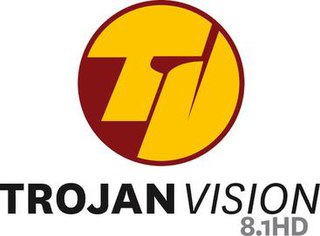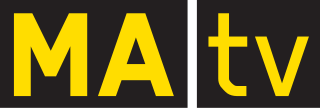Communications in Hong Kong includes a wide-ranging and sophisticated network of radio, television, telephone, Internet, and related online services, reflecting Hong Kong's thriving commerce and international importance.
A television broadcaster or television network is a telecommunications network for the distribution of television content, where a central operation provides programming to many television stations, pay television providers or, in the United States, multichannel video programming distributors. Until the mid-1980s, broadcast programming on television in most countries of the world was dominated by a small number of terrestrial networks. Many early television networks such as the BBC, CBS, CBC, NBC or ABC in the US and in Australia evolved from earlier radio networks.
Public broadcasting involves radio, television, and other electronic media outlets whose primary mission is public service. Public broadcasters receive funding from diverse sources including license fees, individual contributions, public financing, and commercial financing, and avoid political interference or commercial influence.
Television broadcasts in the United Kingdom began in 1932, however, regular broadcasts would only begin four years later. Television began as a public service which was free of advertising, which followed the first demonstration of a transmitted moving image in 1926. Currently, the United Kingdom has a collection of free-to-air, free-to-view and subscription services over a variety of distribution media, through which there are over 480 channels for consumers as well as on-demand content. There are six main channel owners who are responsible for most material viewed.
Public-access television is traditionally a form of non-commercial mass media where the general public can create content television programming which is narrowcast through cable television specialty channels. Public-access television was created in the United States between 1969 and 1971 by the Federal Communications Commission (FCC), under Chairman Dean Burch, based on pioneering work and advocacy of George Stoney, Red Burns, and Sidney Dean.

Rádio e Televisão de Portugal (RTP) is the public service broadcasting organisation of Portugal. It operates four national television channels and three national radio stations, as well as several satellite and cable offerings.

Cable radio is radio broadcasting into homes and businesses via a cable. This can be a coaxial cable used for television, or a telephone line. It is generally used for the same reason as cable TV was in its early days when it was "community antenna television", in order to enhance the quality of over-the-air radio signals that are difficult to receive in an area. However, cable-only radio outlets also exist. It can be both FM or AM.
The Boise Metropolitan Statistical Area is served by six major television stations, two daily newspapers, three major weekly newspapers and 19 major commercial radio stations.
Rogers TV is a group of English-language community channels owned by Rogers Communications. Many of these channels share common programs. Rogers TV broadcasts in the Canadian provinces of New Brunswick, Newfoundland and Labrador and Ontario. Rogers TV is available only in communities served by Rogers' cable and telecom division, and is not carried by other television service providers. Its French counterpart is TV Rogers.
Community television in Canada is a form of media that carries programming of local community interest produced by a cable television company and by independent community groups and distributed by a local cable company.

Trojan Vision is a student television station at the University of Southern California through the School of Cinematic Arts. Established in 1997, Trojan Vision broadcasts 24/7 from the Robert Zemeckis Center for Digital Arts to the University Park Campus on Channel 8.1 and online through their website. Programming is made available to the greater Los Angeles community on local channel LA36.

The Gibraltar Broadcasting Corporation (GBC) is Gibraltar's public service broadcaster. It has provided the community with a radio and television service since 1962.
Swindon Cable was the UK's first commercial Cable TV franchise. It was originally set up by Thorn Ltd as Radio Rentals Cable Television; the local company name was later changed to Swindon Cable. As well as relaying satellite channels it operated its own local cable TV channel known as Swindon's Local Channel. It closed permanently in 2000, after 16 years of broadcasting mostly local programming on the Wiltshire town's cable TV system.

MAtv is a Canadian community channels operated by the cable provider Vidéotron within the province of Quebec.
NVTV, also known as Northern Visions Television, is a local community television station based in the city of Belfast. It is operated by the Northern Visions media and arts project, and although some staff are employed by the station, most involved are volunteers. NVTV is now the only local community station in Northern Ireland.

Swindon 105.5 is a community non-for-profit radio station based in Swindon, England, launched in March 2008. The station manager is former BBC Wiltshire Sound, GWR FM and Swindon Viewpoint presenter, Shirley Ludford. Aside from Shirley being paid part-time, the station is run entirely by volunteers. Shirley also dedicates many voluntary hours each week. The station obtains its funding from grants, donations, fundraising events, training courses and limited on-air sponsorship.
Community television is a form of mass media in which a television station is owned, operated or programmed by a community group to provide television programs of local interest known as local programming.
Greenwich Cablevision was the first community television station in Britain, broadcasting briefly in the Greenwich area of London during the 1970s.
This is a timeline of cable television in the United Kingdom.
This is a timeline of local television in the United Kingdom. This refers to stations transmitting to a small area such as a city or part of a county, not to larger regions covered by ITV and BBC regions.





